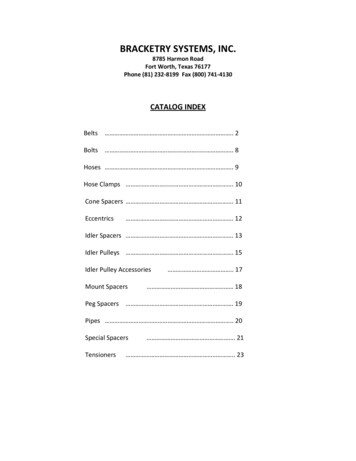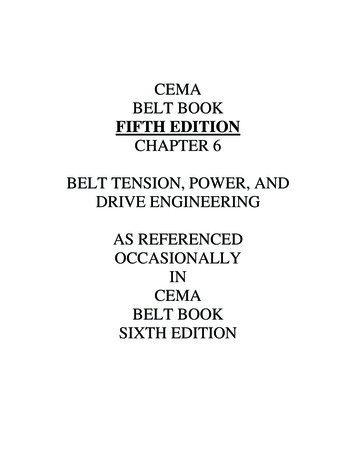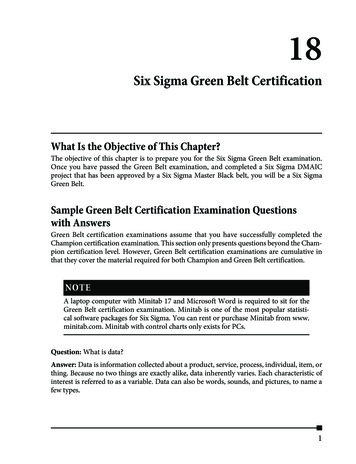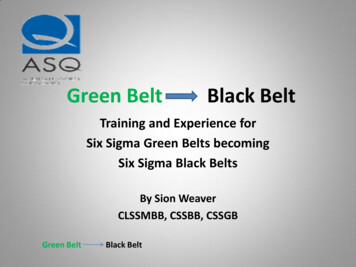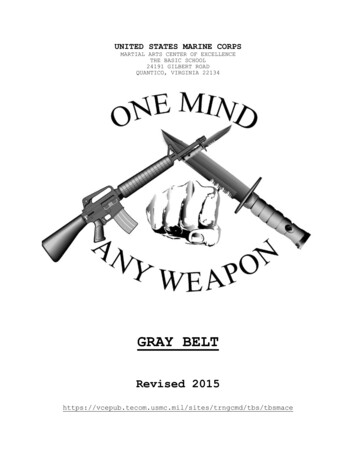
Transcription
UNITED STATES MARINE CORPSMARTIAL ARTS CENTER OF EXCELLENCETHE BASIC SCHOOL24191 GILBERT ROADQUANTICO, VIRGINIA 22134GRAY BELTRevised s/tbsmace
TABLE OF CONTENTSLesson IDLesson TitlePage #MCCS-GRAY-2001BAYONET TECHNIQUES.3MCCS-GRAY-2002UPPER BODY STRIKES.13MCCS-GRAY-2003LOWER BODY OWS.41MCCS-GRAY-2006COUNTERS TO STRIKES.49MCCS-GRAY-2007COUNTERS TO CHOKES AND HOLDS.57MCCS-GRAY-2008UNARMED MANIPULATIONS.65MCCS-GRAY-2009ARMED MANIPULATIONS .73MCCS-GRAY-2010KNIFE TECHNIQUES.83MCCS-GRAY-2012WEAPONS OF OPPORTUNITY.91MCCS-GRAY-2013GROUND FIGHTING.99MCCS-GRAY-2014FORCE CONTINUUM.105MCCS-GRAY-2015MARTIAL CULTURE STUDY: MARINE RAIDERS.113MCCS-GRAY-2016FREE SPARRING.121GUIDED DISCUSSION 1:FUNDAMENTALS OF LEADERSHIP.127GUIDED DISCUSSION 2:HAZING.145GUIDED DISCUSSION 3:COMMITMENT.153GUIDED DISCUSSION 4:TROOP LEADING STEPS.159GUIDED DISCUSSION 5:HONOR.169GUIDED DISCUSSION 6:COURAGE.1751
2
MCCS-GRAY-2001UNITED STATES MARINE CORPSMARTIAL ARTS CENTER OF EXCELLENCETHE BASIC SCHOOL24191 GILBERT ROADQUANTICO, VIRGINIA 22134LESSON PLANBAYONET TECHNIQUESMCCS-GRAY-2001GRAY BELTAPPROVED BY:LtCol (Ret) Shusko, J. C.3DATE: 07/10/2015
MCCS-GRAY-2001UNITED STATES MARINE CORPSMARTIAL ARTS CENTER OF EXCELLENCETHE BASIC SCHOOL24191 GILBERT ROADQUANTICO, VIRGINIA 22134INSTRUCTOR PREPARATION GUIDELESSON TITLE:Bayonet TechniquesLESSON DESIGNATOR:MCCS-GRAY-2001TOTAL LESSON TIME:1 hourREFERENCES:MCO 1500.59NAVMC 3500.41MCRP 3-02BPERSONNEL REQUIRED:One instructor and assistantsFACILITIES:Soft footed training areaREVIEW COURSE MATERIALS: Review Lesson PlanADD PERSONALIZATION: Personalize the lesson by adding subject matter detail,personal experiences, examples, and questions.MATERIALS/EQUIPMENT: Rifle/Training Rifle Bayonet Trainer Wooden Bayonet Trainer Flak Jacket Helmet MouthpieceSETUP AND PLANNING: Reserve Training Area Conduct Rehearsals4
MCCS-GRAY-2001INTRODUCTION(5 MIN)1. GAIN ATTENTION. Our Corps was born in the fire and bloodof revolution and has been forged and tempered in over 230years of conflict and defense of the Nation. The fightingthat took place in battles such as Bloody Ridge, Bairoko, andOkinawa was “Close-In” fighting; fighting consisting ofgrenades, firing rounds while closing, bayoneting and evenknife fighting. Our history in close-in engagements has alsobeen defined by the warrior ethos.2. OVERVIEW. Good morning, my name is . This lessonwill cover bayonet techniques and the warrior ethos.3.POSITIONSINSTRUCTOR NOTE: Assign demonstration and practice positions.Ensure students have enough space, and can see and hear theinstructor.4.SAFETY.To prevent injury, ensure the following:a.Start slowly and increase speed with proficiency.b.Never execute techniques at full force or full speed.c.Training will be conducted in three stages.(1) Marines will execute techniques in the air.(2) Marines will practice strikes on a pad or dummy.(3) Marines will practice during free sparring.d.Before training with firearms, unload and show clear.e.When handling firearms, the weapons safety rules apply.(1) Treat every weapon as if it were loaded.(2) Never point a weapon at anything you do not intend toshoot.(3) Keep your finger straight and off the trigger untilyou are ready to fire.(4) Keep your weapon on “safe” until you intend to fire.f. Conduct all practical application utilizing approvedtraining gear.5
MCCS-GRAY-2001TRANSITION. Now that you know what will be covered are there anyquestions? Let’s discuss the purpose of bayonet techniques.BODY1.(45 MIN)EXPLAINa. Purpose. The purpose of bayonet techniques is to disableor kill an aggressor.b. Principles. The principles for bayonet techniques aremindset, grip, stance, and movement.(1) Mindset. When engaged, your mindset is a factor ofsuccess or failure. Mindset is the "mental trigger" during adefining moment that enables you to commit to an attack. Youmust have the superior mindset against the aggressor to succeed.(2) Grip. It is possible to execute these bayonettechniques while gripping the buttstock of the weapon, but thestress is on being able to execute them from the pistol grip.These are lethal, offensive techniques that can be used inconjunction with assault fire movement.(a) Grab the pistol grip with your right hand. Keepyour trigger finger off the trigger and included it in the grip.(b) With the left hand, grab the hand guards of therifle under-handed.(c) Lock the buttstock of the rifle against the hipwith the right forearm.(d) Keep movements of the bayonet blade within a box,shoulder width across from your neck down to your waistline.Always keep the bayonet end of the rifle oriented toward theaggressor.(3) Stance. All movement begins and ends with themodified basic warrior stance. Create a smaller silhouette andlower center of gravity by lowering your body at the knees andcreate “eye-muzzle-target” toward the aggressor.(4) Movement. Movement is used to get from one place toanother when the threat of contact is imminent. Use a controlledand steady combat glide to avoid tripping while moving toward theaggressor.c. Fundamentals. The fundamentals for bayonet techniquesare approach, close, and entry.6
MCCS-GRAY-2001(1) Approach. Approaching is used when you have locatedthe aggressor. While maintaining a combat glide, move toward theaggressor until you are within 5 to 10 feet. The bayonet muststay locked on the aggressor.(2) Close. As you reach the critical distance of 5 to 10feet, you will use a burst of speed to close the final distancewith the aggressor. Increase your speed by quickening your stepswithout changing your stride length or standing upright. Thiswill cause the aggressor to hesitate and give you thepsychological and tactical advantage.(3) Entry. The entry is made to get inside theaggressor’s defense to conduct a lethal attack. The movement canbe a step forward or to an oblique to get within range.(a) Target Areas. The primary target areas of thebody are the aggressors throat, groin, or face. The aggressor’storso can be another target area if it is not protected by bodyarmor.(b) Striking Surface. Thrusts will use the point ofthe bayonet and slashes will use the cutting edge of the bayonet.Buttstrokes will use the toe of the buttstock off the rifle andsmashes will use the butt of the rifle.TRANSITION: We have covered the purpose, principles, andfundamentals, are there any questions? I will now demonstratethe first technique.2.DEMONSTRATEINSTRUCTOR NOTE: Demonstrate only one technique at a time.Do not explain the steps or open the class for questions.INTERIM TRANSITION:3.Go to practice position one.IMITATEa.Disrupt And Thrust While Closing With A Static Aggressor(1) Assume the modified basic warrior stanceapproximately 20 to 30 feet away from the aggressor.(2) Approach the aggressor by moving at a fast walk,using your legs to absorb the impact of your steps. Ensure thebayonet stays locked on the aggressor and it is not bouncing asyou move.7
MCCS-GRAY-2001(3) As you reach the critical distance of 5 to 10 feetfrom the aggressor you will use a burst of speed to close thefinal distance in a controlled aggressive manner.FAULT CHECK: Allow students to practice approach and closeuntil they become proficient.(4) While closing, disrupt the aggressor’s weapon byrotating your body slightly to the right, moving their bayonetslightly off line. You only need to redirect the aggressor’sweapon a couple of inches to have the weapon miss your body.This will give your blade a clear path to your primary target.FAULT CHECK: The disrupt is performed concurrent with thethrust. It is not an independent movement.(5) Enter by stepping forward and thrusting the blade ofthe weapon directly into the target. Continue to drive throughthe aggressor.(6) Retract to the modified basic warrior stance, scanthe area for additional threats, and prepare for follow onattacks.4.PRACTICEINSTRUCTOR NOTE: Fault check student proficiency and safety.TRANSITION: We have learned bayonet techniques, are there anyquestions? We must also understand the principles of the warriorethos.5.TIE-IN (WARRIOR ETHOS). What is a Marine? Being a Marineis a state of mind. It is an experience some have likened moreto a calling than a profession. Being a Marine is not a job or apay check, nor is it an occupational specialty. It is not maleor female, majority or minority, or a rank insignia. The stars,bars, and chevrons we wear are only indicators of theresponsibility or authority we hold at a given time. Rather,being a Marine comes from the eagle, globe and anchor that istattooed on the soul of every one of us who wears the MarineCorps uniform. It is a searing mark in our innermost being,which comes after the rite of passage through boot camp or OCSwhen a young man or woman is allowed for the first time to say,“I am a United States Marine.” And unlike physical orpsychological scars, which over time tend to heal and fade inintensity, the eagle, globe and anchor only grow more defined and8
MCCS-GRAY-2001intense the longer you are a Marine.Marine.”“Once a Marine, always aa. The determination to be different, and remain different,has manifested itself in many ways over the years; from militaryappearance, to strict obedience to orders, to disciplinedbehavior, to adherence, to traditional standards, and most ofall, to an unyielding conviction that we exist to fight. Marineshave been distinguished by these characteristics from ourbeginning. A sense of elitism has grown from the fact that everyMarine, whether enlisted or officer, goes through the sametraining experience. This training has endowed the Corps with asense of cohesiveness enjoyed by no other American service. Thismatter of being different is at the very heart of leadingMarines. It defines who and what we are by reflecting themystical cords of the mind that bind all Marines. What we are,what we have been, and what Marines will always be is enduring.There is yet another element of being different that definesMarines, and that is selflessness; a spirit that places the selfinterest of the individual second to that of the institution weknow as the Corps. That selflessness is stronger nowhere inAmerican society than among Marines.b. Ordinary men and women-heroes who showed extraordinaryleadership have shaped our ethos and courage, both physical andmoral, as they shaped the special character that is the essenceof our Corps. They are heroes and leaders who are remembered notby their names, or rank, or because they received a decorationfor valor. They are remembered because they were Marines."Success in battle is not a function of how many show up, but whothey are." General Robert Barrow, 27th Commandant of the MarineCorpsc. Individual Marines, like those described above, are thebedrock upon which our Corps spirit is built. From the first dayof recruit training, to their first assignments, to their firstcelebration of the Marine Corps birthday, each Marine is infusedwith an understanding of the deeds of his or her predecessors.Recruit training, both officer and enlisted, has long been thegenesis of the enduring sense of brotherhood that characterizesthe Corps. New recruits are told the day they enter trainingthat, as one Marine leader put it, "A Marine believes in his God,in his Country, in his Corps, in his buddies, and in himself."d. What happens on the parade decks of Parris Island and SanDiego or in the woods of Quantico is what makes Marines. Asnoted in the Leading Marines publication (MCWP 6-11) it is theinstallation of “an intangible esprit along with the complicated,specific knowledge of soldiering.” MCWP 6-11 further goes on todescribe that Marines, as they always have, carry on thetradition as a force in readiness, able and willing to go9
MCCS-GRAY-2001anywhere and do anything. "Trained men who will stand and fightare never obsolete. It was not the bowman, but the long bow, notthe cavalryman, but the horse, which vanished from the scene.Men-the man, the individual who is the Marine Corps symbol andstock-in-trade constitute the one element which never changes."e. Every Marine is a rifleman. There is both a practicaland moral dimension to the credo "every Marine a rifleman." Theforce structure of the Corps reflects its central purpose: anexpeditionary force in readiness. And because it isexpeditionary, it is also austere. Austerity places a premium onthe role of every Marine. There are no "rear area" Marines, andduring expeditionary operations no one is very far from thefighting. The success of each of these operations depends on thespeed and flexibility with which Marines build combat power.f. Marines fighting with maneuver elements are backed up byfellow Marines who labor unceasingly to support the mission bybuilding logistic bases, running truck convoys, distributingsupplies, and fighting when needed. This is nothing new. Thefirst Marine aviator to earn the Medal of Honor in World War II,Captain Henry "Hank" Elrod, was a fighter pilot on Wake Island.His aircraft was destroyed after 15 days of heroic defense of theisland, he died leading a platoon of Marines in ground combat(see MOH citation below). Actions of Marines like Captain Elrodcontinue to demonstrate that every Marine is a rifleman. Theseactions occur with such regularity, that non-Marines often showsurprise on learning that there are any specialties in the Corpsother than the infantry. This perception on the part of others ispart of what makes our Corps, one that transcends occupationalspecialty.g. There is almost nothing more precious to a Marine than afellow Marine. This traditional bond flows from the combattraining which all Marines receive, officer and enlisted, and theshared danger and adversity inherent in expeditionary operations.Those men on the line were my family, my home. Theywere closer to me than I can say, closer than anyfriends had been or ever would be. They had never letme down, and I couldn't do it to them. I had to bewith them, rather than let them die and me live withthe knowledge that I might have saved them.Men, Inow knew, do not fight for flag or country, for theMarine Corps or glory or any other abstraction. Theyfight for one another.Any man in combat who lackscomrades who will die for him, or for whom he iswilling to die, is not a man at all. He is trulydamned.By Sergeant William Manchester, Author and WWIIveteran of Okinawa.10
MCCS-GRAY-2001h. This cohesion between Marines is not a function of aparticular unit within the Corps. It is a function of the Corpsitself. When a Marine reports to a unit, he or she may beunknown personally, but is a known quantity professionally.Regardless of anything else known about them, their leaders knowthat they have been trained as Marines and as such they bear thatindelible stamp of “rifleman." Nowhere is the effect of thismore evident than when Marines are exposed to danger or to war.Fellow Marines, remote from the action, are usually uneasy.Marines are going in harm's way, and there is an unnaturalfeeling of being "left out" among those not able to go. Thisattitude is born of the confidence that every Marine can fight,that every Marine can contribute to the mission, and that everyMarine is duty bound to share in the danger and the risk of everyother Marine in the Corps.i. This "spirit” of confidence comes from training andtradition. Each individual Marine, because of the fightingtradition of the Corps and the toughness of the training, isconfident of his own ability and that of his buddies. That iswhy Marines fight with discipline and steadfastness in thetoughest of situations. This is why when victory or survivalbecomes doubtful, they turn to their belief in themselves, theirbuddies, and their units, fighting for one another, their unit,and the Marine Corps. This confidence in themselves and oneanother very often spells the difference between victory andsurvival or defeat and annihilation.TRANSITION:questions?We have discussed warrior ethos, are there anySUMMARY(10 MIN)During this period of instruction we have covered bayonettechniques and warrior ethos. I am now confident you will beable to use these techniques to kill the enemy if necessary.INSTRUCTOR NOTE: Provide follow-on instructions.11
MCCS-GRAY-200112
MCCS-GRAY-2002UNITED STATES MARINE CORPSMARTIAL ARTS CENTER OF EXCELLENCETHE BASIC SCHOOL24191 GILBERT ROADQUANTICO, VIRGINIA 22134LESSON PLANUPPER BODY STRIKESMCCS-GRAY-2002GRAY BELTAPPROVED BY:LtCol (Ret) Shusko, J. C.13DATE: 07/13/2015
MCCS-GRAY-2002UNITED STATES MARINE CORPSMARTIAL ARTS CENTER OF EXCELLENCETHE BASIC SCHOOL24191 GILBERT ROADQUANTICO, VIRGINIA 22134INSTRUCTOR PREPARATION GUIDELESSON TITLE:Upper Body StrikesLESSON DESIGNATOR:MCCS-GRAY-2002TOTAL LESSON TIME:1 hour 45 minutesREFERENCES:MCO 1500.59NAVMC 3500.41MCRP 3-02BPERSONNEL REQUIRED:One instructor and assistantsFACILITIES:Soft footed training areaREVIEW COURSE MATERIALS: Review Lesson PlanADD PERSONALIZATION: Personalize the lesson by adding subject matter detail,personal experiences, examples, and questions.MATERIALS/EQUIPMENT: Black Leather Gloves Striking PadSETUP AND PLANNING: Reserve Training Area Conduct Rehearsals14
MCCS-GRAY-2002INTRODUCTION(5 MIN)1. GAIN ATTENTION. During your career in the United StatesMarine Corps you will be exposed to many new techniques, such asupper body strikes. The weapons of your body, specifically yourarms and hands, will be used from time to time in an offensiveattack to stun and finish the aggressor. Marines also havefourteen identifiable traits that solidify our character as aleader. These traits are known as leadership traits.2. OVERVIEW. Good morning, my name is . This lessonwill cover upper body strikes and leadership traits.3.POSITIONSINSTRUCTOR NOTE: Assign demonstration and practice positions.Ensure students have enough space, and can see and hear theinstructor.4.SAFETY.To prevent injury, ensure the following:a.Start slowly and increase speed with proficiency.b.Never execute techniques at full force or full speed.c. When executing strikes, ensure the joints are keptslightly bent to avoid hyperextension.d.Training will be conducted in three stages.(1) Marines will execute techniques in the air.(2) Marines will practice strikes on a pad or dummy.(3) Marines will practice during free sparring.TRANSITION. Now that you know what will be covered are there anyquestions? Let’s discuss the purpose of upper body strikes.BODY1.(90 MIN)EXPLAINa. Purpose. The purpose of upper body strikes is to stunthe aggressor or to set him up for follow on techniques.b. Principles. The principles for upper body strikes aregenerating power, muscular tension, follow through, and movement.15
MCCS-GRAY-2002(1) Generating Power. Maximum power is generated byrotating the hips and shoulders into the attack, moving your bodyweight straight forward or backward, or dropping your body weightinto an aggressor. Body weight can be transferred into an attackfrom high to low or from low to high.(2) Muscular Tension. There should be muscular tensionin the hand and forearm at the moment of impact to maximizedamage to the aggressor and to avoid injury to your hand. Thearms are relaxed until the moment of impact.(3) Follow Through. A strike should be delivered so theweapon (e.g., hand, elbow) hits and follows through the target.This technique will inflict maximum damage to the aggressor.Strikes with the arms are executed with heavy hands; the strikeis executed by driving through with the strike to allow theweight of the hand to go through the target.(4) Movement. Your movement will put you in the properposition for launching an attack against your aggressor as wellas to help protect yourself. Movement is initiated from thebasic warrior stance and ends in the basic warrior stance. Eachstrike can be performed with either the left or right armdepending upon your angle of attack, the position of theaggressor, and the vulnerable target areas exposed on theaggressor.c. Fundamentals. The fundamentals for upper body strikesare the striking surface and target areas.(1) Striking Surface. The striking surface for eachupper body strike will maximize the damage given to the aggressorwhile minimizing the damage taken. The striking surface for aknife hand strike is the meaty portion of the hand below thelittle finger extending to the top of the wrist. The chinjab/palm heal strike uses the heal of the hand. The strikingsurface for elbow strikes is two inches above or below the pointof the elbow, depending on your angle of attack.(2) Target Areas. Target areas that should be attackedwith upper body strikes are soft tissue areas such as the eyes,nose, jaw, and throat. The torso can also be attacked as asecondary target. Pinpoint accuracy is not necessary to attackthese areas. Strikes use gross motor skills as opposed to finemotor skills.TRANSITION: We have covered the purpose, principles, andfundamentals, are there any questions? I will now demonstratethe first technique.2.DEMONSTRATE16
MCCS-GRAY-2002INSTRUCTOR NOTE: Demonstrate only one technique at a time.Do not explain the steps or open the class for questions.INTERIM TRANSITION:3.Go to practice position one.IMITATE.a. Outside/Forward Knife Hand Strike. The outside/forwardknife hand strike is used when the primary target area is narrow,for example, to strike the neck between body armor and a helmet.(1) From the basic warrior stance, make a knife hand withyour right hand (like saluting) and bring it back over your rightshoulder and rotate your right hip and shoulder backwards.(2) Thrust your knife hand forward (horizontally) intothe aggressor while rotating your right hip and shoulder forward.(3) Rotate your wrist so your palm is up. Contact shouldbe made on the aggressor with the meaty portion of the knifehand.(4) Follow through the target with your hand and rapidlyreturn to the basic warrior stance.b. Inside/Reverse Knife Hand Strike. The inside/reverseknife hand strike is primarily used after executing theoutside/forward knife hand strike.(1) From the basic warrior stance, make a knife hand withyour right hand (like saluting) and bring it back over your leftshoulder and rotate your right hip and shoulder forward.(2) Thrust your knife hand forward (horizontally) intothe aggressor while rotating your right hip and shoulderbackwards.(3) Rotate your wrist so your palm is down. Contactshould be made on the aggressor with the meaty portion of theknife hand.(4) Follow through the target with your hand and rapidlyreturn to the basic warrior stance.c. Vertical Knife Hand Strike. The vertical knife handstrike is primarily used to attack the back of the neck.17
MCCS-GRAY-2002(1) From the basic warrior stance, make a knife hand withyour right hand (like saluting) and bring it back over your rightshoulder and rotate your right hip and shoulder backwards.(2) Drop your knife hand down (vertically) onto theaggressor while dropping your body weight and rotating your righthip and shoulder forward.(3) Your palm should be facing inboard. Contact shouldbe made on the aggressor with the meaty portion of the knifehand.(4) Follow through the target with your hand and rapidlyreturn to the basic warrior stance.d. Chin Jab/Palm Heel Strike. The chin jab/palm heal strikecan immediately render an aggressor unconscious and causeextensive damage to the neck and spine.(1) From the basic warrior stance, bend your right wristback at a 90 degree angle with your palm facing the aggressor andyour fingers pointing up. Extend your hand into a flat positionwith your fingers bent and joined at the second knuckle.(2) Move forward to close with the aggressor by pushingoff the ball of the right foot to direct your body weight intothe attack from low to high.(3) Thrust the palm of your hand directly up under theaggressor’s chin while rotating your right hip and shoulderforward.(4) The attack should travel up the centerline of theaggressor’s chest to his chin. Contact should be made on theaggressor’s chin with the heal of your palm.(5) Follow through the target with your hand and rapidlyreturn to the basic warrior stance.e. Horizontal Rear Elbow Strike. The horizontal rear elbowstrike is used when being attacked from the rear.(1) From the basic warrior stance, look back over yourshoulder to acquire your target.(2) Thrust your right elbow horizontally backwards towardthe aggressor while taking a slight step backwards to generatepower and bring yourself within striking range of the aggressor.(3) The right forearm is parallel to the deck with thepalm facing the deck.18
MCCS-GRAY-2002(4) Rotate your right hip and shoulder backwards togenerate additional power.(5) Follow through the target with your elbow and rapidlyreturn to the basic warrior stance.f. Vertical Elbow Strike High to Low. The vertical elbowstrike high to low is primarily used to attack the back of theneck when the aggressor is bent over.(1) From the basic warrior stance, bend your right elbow,keeping your fist close to your ear with your elbow at shoulderlevel.(2) Drop your elbow down (vertically) onto the aggressorwhile dropping your body weight and rotating your right hip andshoulder forward.(3) Follow through the target with your elbow and rapidlyreturn to the basic warrior stance.4.PRACTICEINSTRUCTOR NOTE: Fault check student proficiency and safety.After practicing in the air, allow the students to practiceon strike pads. Ensure partners hold the pad correctly.TRANSITION: We have learned upper body strikes, are there anyquestions? Every Marine must also understand and develop theirleadership traits.5. TIE-IN (LEADERSHIP TRAITS). The traits of leadership are thebasic fundamentals Marines use to develop their own leadershipabilities and their subordinates. The results of failure toapply these fundamentals are obvious. For example, a leader'slack of knowledge or judgment could result in the unnecessaryloss of Marines' lives. Our profession is deadly serious when itcomes to the requirements for effective leadership by allMarines. The acronym that helps us remember these importantleadership principles is “JJ-DID-TIEBUCKLE”:a. Judgment. Judgement is the ability to weigh facts andpossible courses of action in order to make sound decisions.Sound judgment allows a leader to make appropriate decisions inthe guidance and training of his Marines and the employment ofhis unit. A Marine who exercises good judgment weighs pros andcons accordingly to arrive at an appropriate decision and takeproper action.19
MCCS-GRAY-2002b. Justice. Justice is giving reward and punishmentaccording to the merits of the case in question. The ability toadminister a system of rewards and punishments impartially andconsistently is critical to a leader’s success. The quality ofdisplaying fairness and impartiality is vital in order to gainthe trust and respect of subordinates and maintain discipline andunit cohesion, particularly in the exercise of responsibility asa leader.c. Dependability. Dependability is the certainty of properperformance of duty. It is the quality that permits a senior toassign a task to a junior with the understanding it will beaccomplished with minimum supervision. This understandingincludes the assumption the initiative will be taken on smallmatters not covered by instructions. It is knowing you canalways be counted on.d. Initiative. Initiative is taking action in the absenceof orders. Since NCOs and junior officers often work withoutclose supervision, emphasis is placed on being a self-starter.Initiative is a founding principle of Marine Corps Warfightingphilosophy.e. Decisiveness. Decisiveness is the ability to makedecisions promptly and to announce them in a clear, forcefulmanner. The quality of character which guides a person toaccumulate all available facts in a circumstance, weigh thefacts, and choose and announce an alternative which seems best.f. Tact. Tact is the ability to deal with others withoutcreating hostility. The quality of consistently treating peers,seniors, and subordinates with respect and courtesy is a sign ofmaturity. Tact allows commands, guidance, and opinions to beexpressed in a constructive and beneficial manner. This deferencemust be extended under all conditions regardless of truefeelings.g. Integrity. Integrity is the uprightness of character andsoundness of moral principles. It is the quality of truthfulnessand honesty. A Marine's word is his bond. Nothing less thancomplete honesty in all of your dealings with subordinates,peers, and superiors is acceptable. For the warrior, integrityis the unity of the mind, body and spirit. It is anunderstanding that a true warrior is only complete when he hastrained himself completely so that his physical prowess iscomplimented by his mental skills and all is under the control ofhis soul. The opposite of integrity is not lying butdisintegration.h. Enthusiasm. Enthusiasm is the display of sincereinterest and exuberance in the performance of duty. Displaying20
MCCS-GRAY-2002interest in a task, and optimism that it can be successfullycompleted, greatly enhance the likelihood the task will besuccessfully completed.i. Bearing. Bearing is creating a favorable impression incarriage, appearance, and personal conduct at all times. It isthe ability to look, act, and speak like a leader whether or notthese manifestations indicate one's true feelings. Some signs o
united states marine corps martial arts center of excellence the basic school 24191 gilbert road quantico, virginia 22134 lesson plan bayonet techniques mccs-gray-2001 gray belt approved by: ltcol (ret) shusko, j. c. date: _07/10/2015_ mccs-gray-2001 4 united states marine corps
